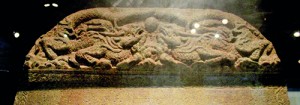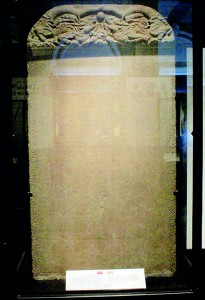
Sunday, 21st September 2014
By Vinusha Paulraj and Purnima Pilapitiya
When General Cheng Ho sailed into Galle harbour six centuries ago

The visit to Sri Lanka this week by the Chinese President Xi Jinping was greeted with great fanfare. While his packed schedule may not have permitted it, the Chinese President may have been interested to know that more than six centuries ago, the visit by a Chinese general of great fame is remembered by a stone inscription reposing in the Colombo Museum.
But the story begins in another port: Galle. Situated down Church Street in Galle Fort, with its walls of faded ochre and high arched windows, the Galle Maritime Museum, built as a warehouse by the Dutch, has for the past few centuries been housing treasures from the sea and those dug-up from the once vibrant port city.
At first sight one of the exhibits seems like an ordinary stone slab, with ornate carvings. Reminiscent of perhaps the moonstone or even just detailed carvings of traditional Sri Lankan patterns. But a closer look at the stone that stands around four feet high, reveals its inscription is more associated with temples and palaces, rather than with ships and sea faring vessels. The head is typically Sri Lankan with its entwined
The stone at the National Museum. Pic by Anuradha Bandara
lotuses.

Adding to the ambiguity of the inscription, are two dragons carved in. The distinct lines and sharp flicks of the calligraphy signify its Chinese origins. The Mandarin letters take up only one third of the inscription making space for the familiar Tamil calligraphy with scatterings of another set of exotic looking symbols; Persian.
The inscription; known simply as the trilingual stone inscription is one of major historical significance and is the only trilingual one of its kind in Sri Lanka. Commissioned by General Cheng Ho (Zheng He in modern Mandarin) of the Chinese Navy, the slab was inscribed in China and gifted to Sri Lanka in 1409.
The significance lies not only in the three languages used on the slab but also in the individual behind it all.
Deputy Director of the Department of Ethnology at the National Museum of Colombo, E.A.S Wickramasinghe explains that Cheng Ho’s travels took him as far as Africa, Europe. The Admiral, said to be of impressive stature, stood more than six feet in height. He rose from being a child slave and eunuch, becoming the first eunuch to be appointed to such a military rank in China. General Ho also opened the gates of China to the rest of the world with his voyages which were not carried out with the aim of trade or warfare, but were merely for exploration and establishing China in the world.
With a fleet of over 300 ships, the Admiral may have set foot on Lankan soil at least close to six or seven times before he made his major voyage to Sri Lanka, explains Mr Wickramasinghe, as Sri Lanka had been a central port in the Indian Ocean.
Commissioned by the General Cheng-Ho the slab was “entirely, made in China” Assistant Director of the Maritime Museum, Krishanthi Bandara says. Bringing it with him to Sri Lanka, in 1411 on his third major voyage, he had ordered its making as early as February 2, 1409.
“It’s not really rules,” etched on the slab she explains. The three languages in unison instruct traders on the duties they owe and are mostly requirements. Translations have revealed that the Chinese text calls for oblations in gratitude to the Lord Buddha for safely arriving at the port.Silks, gold and silver, wax candles, jewelled banners in precise quantities have been clearly deciphered from the inscriptions. The list of alms according to the slab was to be presented to the Buddhist temple in ‘the Mountains of Ceylon.’
The Persian text too speaks of exact quantities for offerings. Embroidered cloth, incense burners and antique lamp stands have been called for in honour of a shrine that the slab calls “the light of Islam.” The Persian script is not as prominently visible as the other two languages.Nevertheless exact measures in ‘Misqal’ and even colour specifications have been spotted by translators.
All the untrained eye can see of the Tamil inscription are a few familiar looking letters. Experts however gather that this too was as elaborate and meticulous as the other two languages. Varying only in that it requires oblation to a certain ‘Lord Tenavarai-nayanar’. Additions to the standard list of Gold and Silver, this list commands Sandalwood and rich anointing oils to be given in worship to the more familiarly termed
While the words on the slab invoke grand visions of the diverse, buzzing port it isn’t clear how long after its installation the words held fast.Discovered in a culvert close to Cripps Road in Galle it was Provincial Engineer H. F. Tomalin who found it five centuries later, in 1911.
Today even finding Cripps Road is a little difficult, Krishanthi Bandara discloses. “The whole place was known as Cheena Koratuwa” and the road, she says was in this area. After careful examination the actual stone was moved to the National Museum in Colombo whereas the stone in the Maritime Museum today is a replica.
From : http://www.sundaytimes.lk/140921/plus/a-visit-marked-in-stone-118621.html




